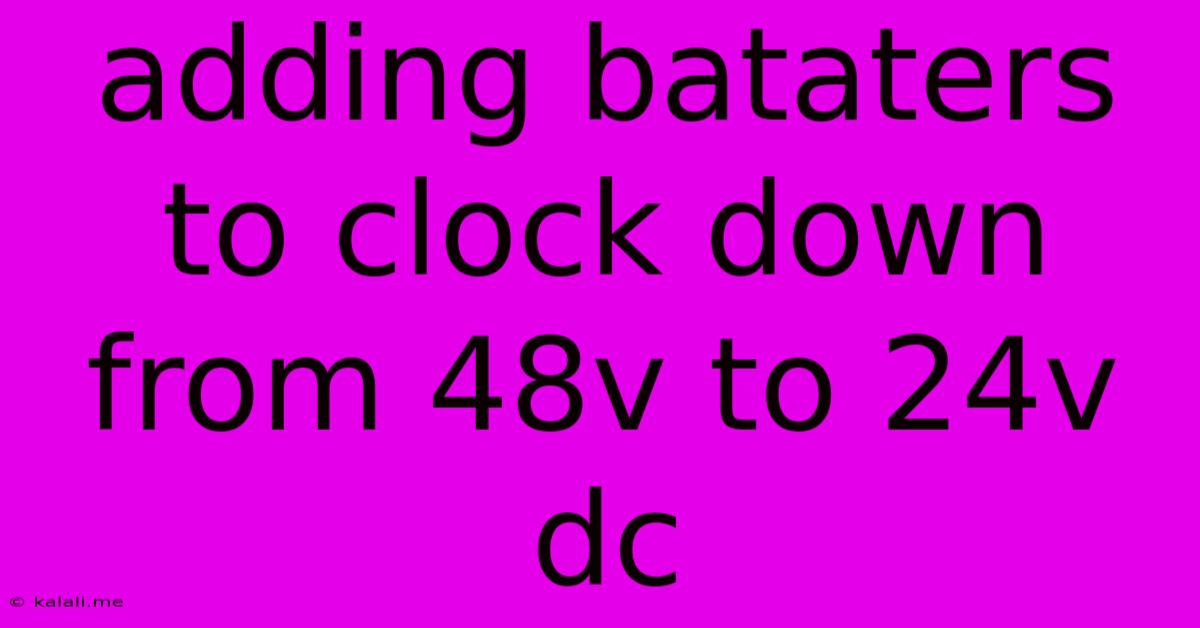Adding Bataters To Clock Down From 48v To 24v Dc
Kalali
Jun 05, 2025 · 3 min read

Table of Contents
Adding Batteries to Step Down from 48V to 24V DC
Stepping down voltage from 48V DC to 24V DC is a common requirement in various applications, from electric vehicles to industrial power systems. While DC-DC converters are the standard solution, using batteries in conjunction with a suitable circuit can offer advantages in specific scenarios. This article explores how adding batteries can achieve this voltage reduction, along with the considerations and limitations involved.
This method isn't about directly using the batteries to convert the voltage, but rather to absorb the excess voltage and provide a stable 24V output. It's a simple technique, best suited for situations where precise voltage regulation isn't crucial, and current demands are relatively low and consistent. Think of it as a voltage "buffer" or "dropping" solution rather than a sophisticated conversion.
Why Use Batteries for Voltage Reduction?
- Simplicity: For low-power applications, this can be a simpler and potentially cheaper solution than a complex DC-DC converter.
- Redundancy: If the 48V supply fails, the batteries can provide backup power at 24V. This is particularly useful in critical applications.
- Smoothing: Batteries can help smooth out voltage fluctuations in the 48V input, providing a more stable 24V output.
How to Implement a Battery-Based 48V to 24V Step-Down
The key is to connect a set of batteries in series to create a 24V bank. This 24V bank is then connected in parallel with the load. However, this requires careful circuit design to prevent damage to the batteries and the load. You'll need a crucial component: diodes.
-
The 24V Battery Bank: Connect batteries (e.g., lead-acid, lithium-ion) in series to achieve a total voltage of 24V. The capacity of the batteries will depend on your power requirements and how long you need the 24V supply.
-
Diode Protection: Crucially, you need to use diodes to prevent backflow of current. This prevents the 48V supply from damaging the 24V battery bank and vice-versa. Connect a diode in series with the 48V supply, directing current towards the load. Connect another diode in series with the 24V battery bank, directing current from the bank to the load. This creates a sort of "or" situation where the load is powered either by the 48V supply or the 24V battery bank, but never simultaneously and never in reverse.
-
The Load: Connect your 24V load in parallel to both the diode-protected 48V supply and the diode-protected 24V battery bank. This allows the load to draw power from whichever source is capable.
Circuit Diagram (Simplified):
48V Supply ---|>---[Load]---|>--- 24V Battery Bank
|> represents a diode. Remember, this is a simplified representation. A real-world implementation may require additional components for safety and efficiency.
Limitations and Considerations:
- Voltage Regulation: This method offers minimal voltage regulation. The output voltage will fluctuate depending on the 48V input voltage and the battery state of charge.
- Efficiency: The efficiency is relatively low due to voltage drop across the diodes. Energy is lost as heat.
- Battery Life: The battery bank's life will be significantly affected by the current draw and discharge cycles.
- Safety: Improperly designed circuits can lead to overcharging, overheating, and potential fire hazards. Consult an electrician if you're unsure about the safety implications.
- Current Capacity: The 24V battery bank must have sufficient current capacity to supply the load's demand.
Conclusion:
Using batteries to step down from 48V to 24V DC is a feasible approach for low-power applications requiring simplicity or backup power. However, it's crucial to understand its limitations, and prioritize safety and proper circuit design. For higher-power or more precise voltage regulation applications, a dedicated DC-DC converter is a far better and safer choice. This method is best considered a simple, low-cost solution for very specific niche applications with careful consideration for the inherent limitations.
Latest Posts
Latest Posts
-
Error Constructing Proxy For Org Gnome Terminal Org Gnome Terminal Factory0
Jun 06, 2025
-
All The Kings Horses And All The Kings Men
Jun 06, 2025
-
Can Your Gpa Increase For Earning Extra Credits
Jun 06, 2025
-
How Do You Determine A Turtles Age
Jun 06, 2025
-
What Are Characters Called In A Play
Jun 06, 2025
Related Post
Thank you for visiting our website which covers about Adding Bataters To Clock Down From 48v To 24v Dc . We hope the information provided has been useful to you. Feel free to contact us if you have any questions or need further assistance. See you next time and don't miss to bookmark.